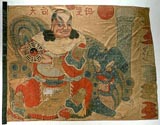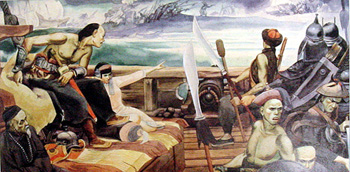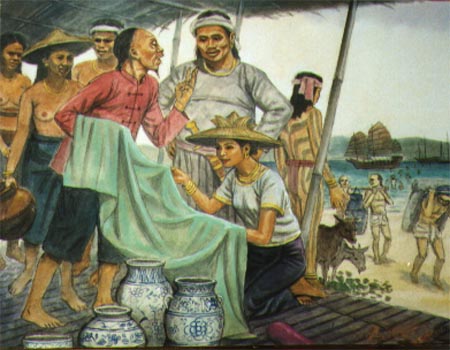
Limahong
Limahong, Lim Hong or also called Lin Feng (simplified Chinese: 林风; traditional Chinese: 林風; pinyin: Lín Fēng; Pe̍h-ōe-jī: Lîm-Hong) was a notorious Chinese pirate and warlord who invaded the northern Philippine Islands in 1574. He built up a reputation for his constant raids to ports in Guangdong, Fujian and southern China. He is noted to have twice attempted, and failed, to overthrow the Spanish city of Manila in 1574.
Birth and origins
Born Dim Mhon to a parents with questionable morals in the city of Tru Cheo (Teochew) in the province of Cuy Tan (called Catim by the Portuguese during the middle of the 16th century). Known to be called Limahong. Exposed to vices, he resorted to criminal activities, including robbery, at an early age. He met and became a protege of an old pirate, Tial-lao. When Tial-lao died, Lim became his heir, inheriting the old pirate’s fleet and around 2,000 pirates. His activities and attacks on ports and ships throughout southern China increased and a warrant was issued by the authorities to capture him alive and send him to the city of Tay Bin. He was married to Nataracy.
He shifted his activities to piracy on the high seas and out of reach of China’s power. He was able to accumulate up to 40 ships, whereupon he once again raided cities and ports in southern China. Limahong attacked a city occupied by Vinh To Quiam, another pirate, but Vinh was able to escape along with 5 of Limahong’s ships. However, Limahong was able to capture 55 of Vinh’s fleet and thus increased his own to 95 ships. He was now a veritable king of the high seas of southern China.
In late 1573, he gathered an army of 3,000 Chinese warriors, renegades and vagabonds and fled to the island of Luzon. There, he and his band of outlaws sought refuge, established their own kingdom and waged war with the Spaniards.
By this time, a force of 40,000 soldiers and 135 ships was sent by the Chinese to kill and capture Limahong. Limahong and his troops first arrived in Ilocos Sur in early 1574 where they quarrelled with the Spanish commander, Juan de Salcedo. After a brief struggle with the Spanish army, his troops were driven away from the city. The pirates then chanced upon merchant ships from Manila doing trade with the Chinese, and learned from 2 captured ships that Manila was a new and relatively unprotected Spanish settlement. From this information and the knowledge that China had a no-war policy with its neighbors during that time, he decided to capture Manila and establish himself as ruler of his would-be kingdom and stronghold.
Limahong In Parañaque (Don Galo)
It was November 29, 1574. The inhabitants of the town of Parañaque, a royal encomienda, was under heavy attack from the forces of the notorious Chinese pirate, Limahong, who were on their way to Intramuros, the seat of Spanish rule in the Philippines. Folk accounts have it that the inhabitants were at first disorganized, until a man from a barrio, by the name of Galo, came forward and took command. Under his able leadership, and with the arrival of Spanish forces led by Captain Juan de Salcedo from Ilocos, Limahong was repulsed and the occupation of the town was prevented.
The stiff resistance of the barrio residents shocked the Chinese pirate, who thought that capturing Manila would be easy. What Limahong did not expect was that the defenders of the community, that would later be known as Dongalo, dispite being ill-equipped, would fight to the end, so much so that the sea in front of the barrio turned red with their blood.
The battle became known as the “Red Sea Incident”
The Paraqueños not only saved their town, but they contributed decisively to Limahong’s abandoning his plans to conquer the area. In appreciation for Galo’s leadership and heroic deeds, the Spanish authorities granted him the title of “Don”. The barrio later on was named after him. Thus, Don Galo or Dongalo.
Limahong In Pangasinan
Foiled at Manila to establish a kingdom of his own, Limahong set sail for the Lingayen Gulf, to settle in Pangasinan province. As a rich place and far enough from the reach of the Spaniards and the Chinese emperor, Limahong resolved to stay here and to make himself master of the region.
Near the mouth of the Agno River about four miles from the sea he built a fort consisting of an outer palisade of palm logs, and an inner enclosure of palm planks which sheltered his palace. He also built pagodas and dwelling places preparatory for permanent settlement.
Limahong announced to the people that he had conquered the Spaniards and that he had come to rule over them as their king. They were commanded to pay tributes to him.
Thereupon, great terror and fright filled all the neighboring villages, and all of them, with no exception, received Limahong as king, and they obeyed him and paid him tributes. To make matters worse for the natives, he seized their principal chiefs and held them as hostages.
The Spaniards could not tolerate the presence of this Chinese corsair in their neighborhood. A scout ship had been sent by Governor Lavezares to follow the pirate fleet and it soon returned and reported where it had gone. An expedition of 256 Spaniards and about 2,500 Filipino troops, including the Rajah Lakandula of Tondo and his sons, set sail in 59 vessels for Lingayen on the 23rd of March, 1575.
In Pangasinan, the motley army was swelled by the addition of some companies of Pangasinan soldiers. They crossed the bar of the Agno River on the 30th of March, 1574, their presence unsuspected by the Chinese.
Captain Juan de Salcedo had been appointed Field Marshal in place of Martin de Goiti. He was assisted by Captain Lorenzo Chacon, Pedro de Chavez, and Gabriel de Rivera (sic). Salcedo noted on entering the river, a narrow place where the channel could easily be blocked. He stayed there in order to prevent the escape of the pirates. He ordered Captain Gabriel de Rivera and his company of 28 men to march immediately by land, and Captains Pedro de Chavez and Lorenzo Chacon to sail with 9 small boats and 80 men to ascend the river and to capture Chinese vessels with the Spanish fleet. The time was to be appointed so that both the land and the sea forces would arrive at the fort at the same instant, and make assault at the same time, so that they might be better successful in their purpose. Salcedo was to remain behind with all the rest of the forces to await the opportunity of furnishing aid in any emergency.
The river detachment met 35 vessels of the Chinese fleet sailing out to collect provisions. They were entirely unaware of the presence of the enemy in the vicinity, and when the Spaniards opened fire with their arquebuses, the pirates turned and fled grounding the ships at the river bank near the fort and then jumping overboard to escape the Spaniards, whom they outnumbered ten to one.
Destruction of the Chinese Fleet
The balance of the Chinese fleet which was just farther up the river was tied up near the river bank with only the crews on board. When these sailors saw their comrades fleeing for their lives, they followed, and the entire fleet was abandoned to the Spaniards. During the melee, one of the vessels caught fire and before anything could be done, the Chinese fleet of over 60 vessels was already in flames.
The land party on the other hand, had forced an entrance into the back side of the port, capturing more than seventy women whom they found within the palisade, besides killing more than one hundred Chinese. Shortly after the Spaniards gained entrance, the fort was put into flames, whether by Chinese or by native auxiliaries could not be determined.
The river party joined in the attack on the fort. But the flames blowing into the faces of the attackers make progress difficult. The inner fort remained inviolate. The attackers stayed and blockaded the inner fort with an aim to starve the Chinese occupants inside. But thirst instead set in among them as the only water available in the fort was only from a small brackish well. Many of them left their ranks to collect loot and slaves.
A Beleaguered Fort
Limahong with his men constructed some boats inside the fort out of the half burnt remnants of his fleet which his men had brought into the fort at night without being detected by the Spaniards. The Chinese had made good use of the blockade also which lasted for three months by repairing the breaches on the walls and the damage of the fire which almost gutted his inner fort.
Under such circumstances, Salcedo’s effort to blockade the Chinese fort seemed fruitless. A Council of War was called to plan other means to expel the Chinese from their fort. It was decided that the Spanish force should retire to an island in the river to make their blockade more effective.
The Chinese were exactly opposite the island, that is, they were north of it, in the words of Francisco de Sande. But what is more interesting is the fact that the island was within cannon shot of the fort; and one morning the Chinese trained the captured cannon Vigilantib on the camp and shattered the leg of standard bearer of Salcedo.
The Elusive Limahong: His Escape
The blockade seemed to be fruitless. Neither side would take the risk of decisive operations and the war degenerated into skirmishes between small bodies of Spaniards and some parties of Chinese going out for provisions to cut wood.
During this period, the pirate Limahong began the construction of thirty vessels within the fort, and as all his soldiers were good workmen, the project was completed on August 4, 1575.
At noon, on the same day, he set sail for his country after having been besieged within the fortification for over four months. This development took the Spaniards by surprise. They were astonished to see Limahong sailing out of fort through a channel which was unknown to them. It was believed and is still current among the natives of the locality, that Limahong constructed this channel with the utmost secrecy without either the land or sea force hearing it.
As a last effort to cut down Limahong, the ingenious Salcedo ordered his soldiers to drive stakes into the bed of the river where Limahong’s ships were sure to pass. While on both banks of the river he had his men concealed ready to subject the pirates to a blinding fire.
Limahong finally arrived at the particular spot where the stakes were driven. Here, amidst blinding fires, Limahong had ropes fastened about the shoulders of his men and at the point of the sword, they were forced to go overboard. Then wrapping arms and legs about the stakes to act as human grappling hooks, the Chinese began their ugly job of pulling the stakes.
Thus, the unhappy wretches in the water, in addition to being almost pulled limb to limb in an effort to dislodge the stakes, were subjected to the fires of the Spanish arms. With great difficulty, enough stakes were removed and the pirate ships escaped to the China Sea passing through the mouth of the Agno River between Lingayen and Labrador. Limahong slipped, and made a wild dash for liberty out into the China Sea toward his former lair, reaching the island of Tocaotican “where he had sought refuge, dying of melancholy because of his reverses.”
A Belated “Visitor”
Shortly after the escape of Limahong from Pangasinan, Captain Omoncon, who was commissioned by his emperor to capture Limahong dead or alive, arrived in Philippine waters and encountered the Spanish soldiers at Bolinao, Pangasinan.
Upon being informed that Limahong escaped from Pangasinan in unworthy vessels out into the stormy China Sea with a slim chance to survive, he was very much overjoyed. From Pangasinan, Captain Omoncon went to Manila accompanied by Field Marshal Salcedo where the former was dined and entertained.
To cap it all, the governor ordered Salcedo and the soldiers to deliver to Captain Omoncon all Chinese pirates captured in Pangasinan, binding himself to pay to the soldiers to whom such belonged the appraised value of the captives.
This done, he ordered everything necessary for the voyage to be fully prepared, which was done within a few days. In return for all this kindness, Captain Omoncon agreed to take along with him to China some Augustinian fathers to spread Roman Catholicism. He finally departed with the fathers amidst the salvo of good-will and friendship.
Limahong’s Legacy to Pangasinan
Today, many of the native Pangasinenses possess some tint of Chinese blood in their veins, and they are still distinguishable by their oblique eyes and light yellow complexion. Many citizens of Lingayen and other towns in this part of the province and along the Agno River are of Chinese ancestry.
References and further reading
* Gambe, Annabelle R., Overseas Chinese Entrepreneurship and Capitalist Development in Southeast Asia (Munster, Hamburg and London: Lit Verlag, 1999).
* Stearn, Duncan, Chronology of South-East Asian History 1400-1996 (Dee Why, NSW: The Mitraphab Centre Pty Ltd., 1997).
* “La Relación del suceso de la venida del tirano chino del gobernador Guido de Lavezares (1575): Épica española en Asia en el siglo XVI:” Edición, transcripción y notas (incluye facsimil del manuscrito original), Juan Francisco Maura. Lemir (Departamento de Filología Hispánica de la Universidad de Valencia), <http://parnaseo.uv.es/Lemir/Textos/Maura/Index.htm> 2004.
* Morga , Antonio de. (2004). The Project Gutenberg Edition Book : History of the Philippine Islands – 1521 to the beginning of the XVII century. Volume 1 and 2.
* Blair , Emma H. (2004). The Philippine Islands, 1493 – 1898 . Volume VI
From Wikipedia, the free encyclopedia
Limahong Descendants in Batangas:
http://www.limjoco.net/lim_ah_hong.html


















